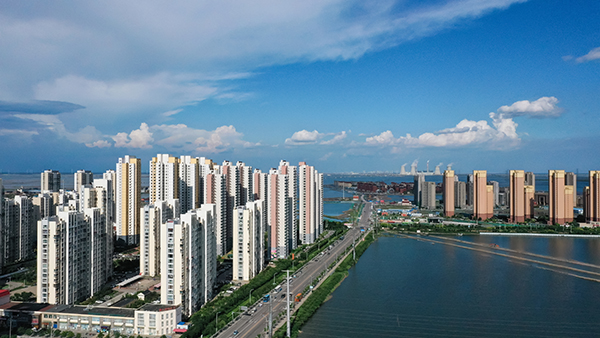Zhaishang Subdistrict
Updated : 2023-06-12
Print Print
Zhaishang Subdistrict locates in the northeastern part of Binhai New Area. It is bordered by the Bohai Bay to the south, the Jiyun River to the west, and extends northward to Hangu Street and Yangjiabo Town. To the east, it is adjacent to the Jianshui River in Hebei Province. With a total area of 118.96 square kilometers and a coastline of 37.19 kilometers (including 8.94 kilometers of natural coastline), Zhaishang administrates 11 communities and 2 administrative villages. It has a total of 28,000 households and a residential population of approximately 60,000 people.
The subdistrict enjoys significant advantages in terms of location and transportation. It benefits from a well-developed road network and convenient external transportation connections. Central Avenue, Hanbei Road, and Dafeng Road, among other high-grade highways, connect the north and south of the new area. Four expressways, including Changchun-Shenzhen Expressway, Binhai New Area-Baoding Expressway, Seaside Expressway, and West Outer Ring Expressway, pass through the area. The under-construction Binhai Line 2 (formerly Z4 Line) seamlessly connects with Tianjin Light Rail Line 9 and Binhai Line 1, forming a one-hour commuting "living circle" that links Tianjin city, the core area of Binhai, Tianjin Airport, and Tianjin Port.
Zhaishang has a rich historical and cultural heritage. With a long history, it derived its name from being the location where Emperor Taizong of the Tang Dynasty (618-907) stationed troops during his campaign against Goguryeo. "Zhaishang" refers to "setting up a camp," and "Yingcheng" refers to "garrisoning a city." Zhaishang is situated between the river and the sea, flourishing through salt production and relying on its proximity to the coast. The marine culture, salt and fishing culture, folk culture, and culinary culture blend together, showcasing distinct characteristics. The "Caijiabao Feicha" tradition has been listed as a national intangible cultural heritage. Legends such as the "Salt Mother and Salt Mother Temple," "Eight Traditional Snacks of Hangu," and the "Changlu Salt-making Technique" have been recognized as the third batch of Tianjin's intangible cultural heritages. Traditional cultural forms such as Pingju opera, woodblock printing, women's calligraphy (Nüshu), and fisherman songs have become iconic cultural symbols of Zhaishang.
The industrial development foundation is solid. The subdistrict currently has 543 enterprises with production and operational capabilities, including 17 national high-tech enterprises, two emerging enterprises, and one leading enterprise. There are a total of 64 enterprises categorized as large-scale industrial and commercial businesses, including 20 industrial enterprises and 22 commercial enterprises. These enterprises have achieved an average annual industrial output value of nearly ten billion yuan (including Beijiang Power Plant), with an average annual total tax revenue of 900 million yuan. The subdistrict has one district-level industrial park, the Yingcheng Industrial Agglomeration Zone, covering an area of 3.43 square kilometers. There are 95 registered enterprises, including 54 production-oriented industrial enterprises. The dominant industries are lubricating oils and related industries, chemicals, and metal products (including steel structures), with an average annual industrial output value of about 4 billion yuan.
The subdistrict boasts rich and diverse tourism resources. Zhaishang is home to a 212-hectare coastal tidal flat and the Dashentang Oyster Reef, a national-level marine special protection area covering 34 square kilometers. In the end of 2020, it was incorporated into the Tianjin Binhai National Marine Park. The subdistrict features vast salt ponds spanning thousands of hectares and a millennium-old "Rainbow Salt Field," forming a unique and comprehensive wetland landscape that captivates visitors. The Dashentang Village, hailed as the last fishing village in Tianjin, is located here. Within the village, fishing boats flow in and out of the "Shengang" port, while seabirds soar above. As the location where the first ray of dawn illuminates the city of Tianjin, it has emerged as a sought-after destination for tourists from the Beijing-Tianjin-Hebei region, offering a delightful coastal leisure experience and countless opportunities to create cherished memories.